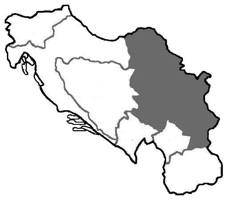
|
The Society of Folk Dance Historians (SFDH)
About Biserka-Bojerka
[
Home |
About |
Encyclopedia | CLICK AN IMAGE TO ENLARGE |

|
 Biserka-Bojerka (note spelling: NOT BojArka) are two different melodies, to which the same dance was done, in urban circles (ahem!) in Belgrade, Kragujevac, Niš, and possibly Novi Sad, around the turn of century. Combining them was the work of Radio-Televizija Beograd, on a 78 rpm white label entitled simply Biserka issued in the early 1950s (pre-1954). Rickey Holden of Folkraft Records then issued the same recording as Biserka-Bojerka after consulting with Desa Đjordjević in Belgrade and learning about the dance Bojerka having the same steps as Biserka. Both are described in the Jankiović sisters' "Narodne igre" Vol I. Also, I believe I recall both melodies being in Bosnjaković's "Narodne igre za klavir," Belgrade, around 1952.
Biserka-Bojerka (note spelling: NOT BojArka) are two different melodies, to which the same dance was done, in urban circles (ahem!) in Belgrade, Kragujevac, Niš, and possibly Novi Sad, around the turn of century. Combining them was the work of Radio-Televizija Beograd, on a 78 rpm white label entitled simply Biserka issued in the early 1950s (pre-1954). Rickey Holden of Folkraft Records then issued the same recording as Biserka-Bojerka after consulting with Desa Đjordjević in Belgrade and learning about the dance Bojerka having the same steps as Biserka. Both are described in the Jankiović sisters' "Narodne igre" Vol I. Also, I believe I recall both melodies being in Bosnjaković's "Narodne igre za klavir," Belgrade, around 1952.
There is absolutely no "Russian influence" here in terms of origin, dance steps, melody, or title. There is only a coincidence in the fact that both the Russian and Romanian languages share reflexes of the Old Slavonic word "bojar" (Russian "bojarin," Romanian "boier"), which in both countries referred to a sort of "middle class aristocracy" second only to a prince. We know the word mainly from the opera Boris Godunov. In Romania there are many dances entitled "boieresc," "boiereasca," "boiereşte," etc. and some of them (including the one [Boiereasca] I have been using as a warm-up dance for many years) have the same basic step pattern as Biserka-Bojerka. The Serb upper classes of the late 19th century loved Romanian imported music and musicians. I have no doubt that the name "bojerka" was the Serbian translation of a Romanian melody named "boiereasca," just as the Serbian Kolo "dunjeranke or dunje ranke" is the serialized Romanian Dunareanca [meaning "Danube girl"], Kokonješte is the Serbian phonetics for the Romanian "Coconeşte" ["dance of a young nobleman"], etc.
In terms of dance movements, the step pattern is known in Serbian under many names and done to many melodies: Sarajevka, Devojaško Kolo, Šetnja, Radikalka, Haj Haj Bože Daj, etc. (all conventionally notated in 2/4 time; Biserka and Bojerka are variously notated as 3/4 and 3/8), and is known in Romania as Hora Mare, Hora de la Campulung, Hora Moldovenească, Hora Unirii (conventionally notated in 2/4, 4/4, 6/4 and 6/8 time). It is also the prototype step pattern of Bulgarian Dobrudžan dances named ŭk and Romanian [Dobrogea] dances named Hora de Mana, both the Bulgarian< and Romanian names meaning "hand").
I used to have a theory that this step pattern was archetypally common to the lower (southern) Danube river valley, disregarding ethnic boundaries, but have never followed up on that research.
Interestingly, in Russia the term "bojarin," feminine "bojarynja," had, by the time of the Revolution, been colloquialized to the terms "barin" and "barynja," by which lower-class Russians (servants, fiacre [a small carriage for hire] drivers, market women) addressed anyone of a superior class. And indeed, a tune entitled "Barynja" became an extremely popular melody to accompany the improvised solo or couple dance of the "pljaska" or "perepljas" genre. There is absolutely no connection, however, between the Serbian "bojerka" and the Russian "barynja."
By the way, Biserka is a Serbian female first name, derived from the word "biser" meaning "pearl" or, sometimes figuratively, "jewel."
Hope the above stream of consciousness isn't too convoluted! Please feel free to pass it on to anyone interested.
Primi puno bratskih pozdrava!
–Dick Crum
DOCUMENTS
- Balkans, a region.
- Biserka-Bojerka, a dance.
- Dick Crum, an article.
- Serbia, a country.
- Yugoslavia, a former country.
This page © 2018 by Ron Houston.
Please do not copy any part of this page without including this copyright notice.
Please do not copy small portions out of context.
Please do not copy large portions without permission from Ron Houston.